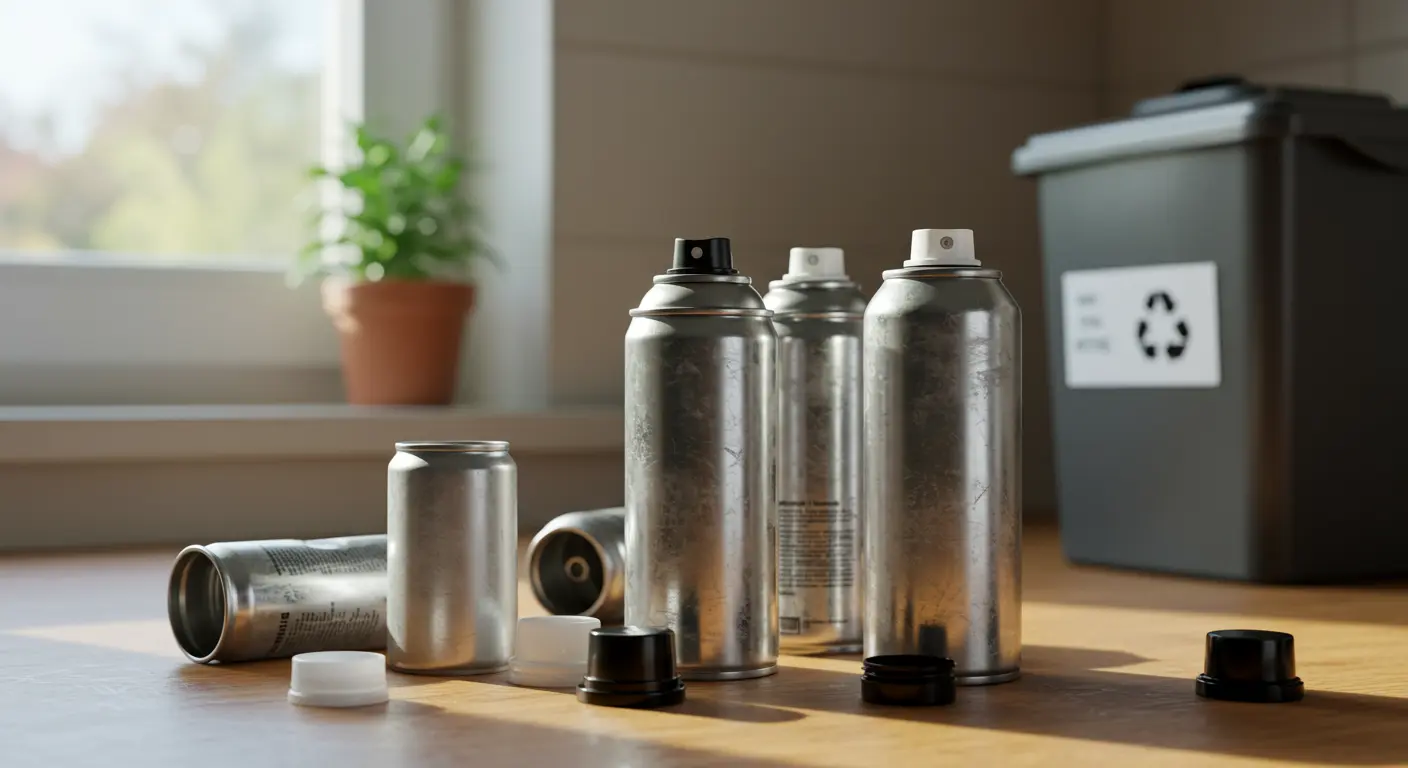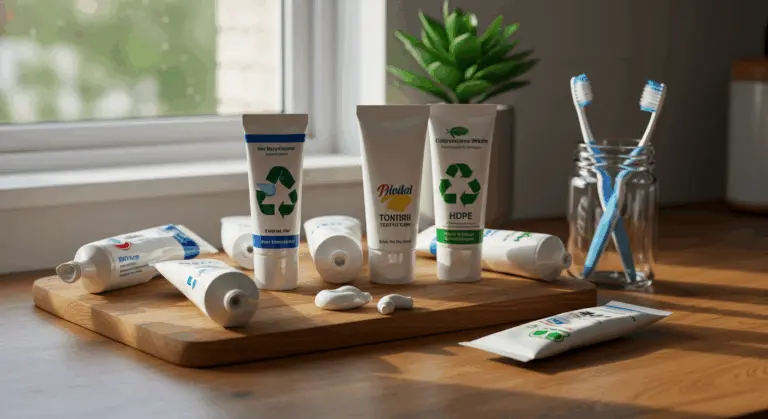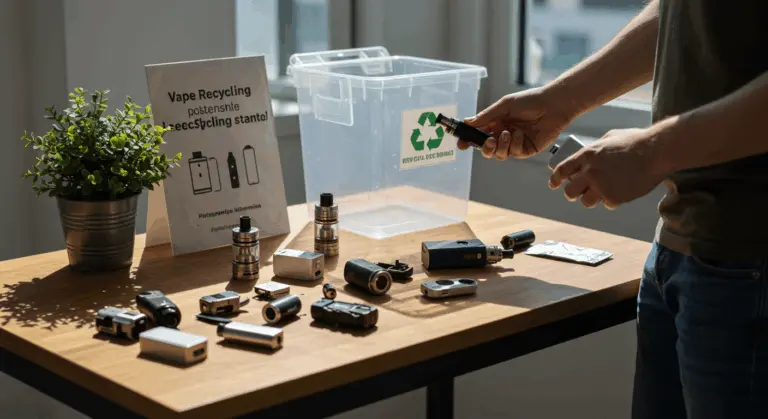Understanding Aerosol Cans – Materials and Composition
While their metal composition makes them recyclable, proper preparation is essential when dealing with the inherent risks of pressurized containers.
Aerosol cans rely on propellants to dispense a wide array of products:
-
Deodorants
-
Air fresheners
-
Cooking sprays
-
Paints
This pressurized design presents recycling challenges, especially when combined with potentially hazardous contents.
Most aerosol cans feature a plastic cap crafted from polypropylene (commonly labeled as #5 plastic). This cap serves both functional and aesthetic purposes but demands separate handling during recycling. This separation is necessary because The plastic cap and metal container follow entirely different recycling streams, making it essential to remove the cap before placing the metal can in your recycling bin. The plastic components can typically be recycled with other plastic materials, though this depends on your local recycling program’s specific capabilities.
An aerosol can’s internal architecture encompasses:
-
A valve mechanism
-
A dip tube
-
A mixing ball (in some cans)
Fortunately, modern recycling facilities can typically process these components within the metal stream—provided the can is completely empty.
Recycling Aerosol Cans – What You Need to Know
Recycling aerosol cans demands specific preparation steps to ensure both safety and proper processing. The most critical requirement: Aerosol cans must be completely empty before recycling. Partially full cans or those containing liquid residue are classified as hazardous waste and cannot be processed through standard recycling streams.
Recycling programs vary significantly by location, so it’s important to verify your local authority’s specific guidelines.
The primary concern with non-empty aerosol cans lies in their pressurized nature. Any remaining product or propellant creates a significant safety hazard during transportation and processing. These pressurized containers can potentially explode or combust when compressed in recycling equipment. This poses genuine risks to waste management workers and facilities.
Proper disposal depends on the can’s condition:
-
Empty Cans: After removing the plastic cap, these can typically join your regular metal recycling stream.
-
Partially Full Cans: These are considered hazardous waste and must be taken to a local household hazardous waste (HHW) facility.
When preparing aerosol cans for recycling, ensure they’re completely free from residual debris or product. This principle of ensuring containers are clean and properly prepared applies equally to other recyclable metals like tin, aluminum, and steel—all according to local guidelines.
Emptying Aerosol Cans – Why It Matters
Properly emptying aerosol cans is an important step in the disposal process, directly impacting both safety and environmental compliance. When an aerosol can is completely emptied and depressurized, it transforms—from potentially hazardous waste to regular recyclable material. According to EPA guidelines, only fully emptied aerosol cans qualify for standard waste disposal or recycling streams.
The regulatory framework for aerosol can disposal focuses primarily on contents rather than the container itself. If either the product inside or the propellant is classified as hazardous, the entire can must be treated as hazardous waste unless properly emptied. The EPA’s Resource Conservation and Recovery Act (RCRA) establishes specific thresholds: a properly emptied can should contain no more than 1 inch or 3 percent by weight of its original hazardous contents.
For household use, the emptying process is straightforward when the can functions correctly. Simply depress the nozzle until no more product emerges and no hissing sound is heard—this indicates the propellant is exhausted. If the nozzle is damaged or product remains that cannot be sprayed out, the can becomes problematic. In these cases, the aerosol can must be taken to a household hazardous waste collection facility rather than placed in regular trash or recycling.
This emptying requirement serves multiple purposes:
-
Prevents reactive chemicals from contaminating recycling streams.
-
Eliminates explosion risks during transportation and processing.
-
Ensures that valuable metal components can be safely recovered.
Local Recycling Programs – How to Find Information
Finding the right recycling program for your aerosol cans requires some research, but several resources make this process easier. Your first step should be contacting your local government or municipality, as recycling regulations and capabilities vary significantly by location. Many cities and counties maintain dedicated webpages or hotlines specifically for waste management questions.
For curbside recycling participants, reach out directly to your service provider for their specific guidelines on aerosol can acceptance. These providers often maintain detailed brochures or online resources outlining exactly what can and cannot be placed in your recycling bin. If curbside recycling isn’t available in your area, locate nearby drop-off recycling centers that may accept properly prepared aerosol cans.
Several online tools can help you find local recycling options:
-
Earth911 and Recycle Nation: Offer search engines to find facilities by zip code.
-
Green Citizen: Provides a directory of environmentally responsible businesses, including recycling centers.
Don’t overlook alternative recycling channels, such as:
-
scrapyards that accept empty metal cans.
-
Manufacturer take-back programs.
-
E-waste recyclers for specialized electronic cleaning aerosols.
Before transporting your aerosol cans to any facility, call ahead to confirm their current acceptance policies and preparation requirements. Recycling capabilities can shift based on market conditions and local regulations, so confirming this information saves time and ensures proper disposal. Many recycling programs also offer downloadable guides like ‘What’s Recyclable’ that provide quick reference information for common household items, including aerosol containers.
Hazardous Waste and Aerosol Cans – Regulations to Follow
Most recycling programs prohibit cans that held hazardous materials, such as:
-
Pesticides
-
Automotive fluids
-
Industrial solvents
-
Certain cleaning chemicals
The proper disposal method hinges on whether the can still contains product. For completely empty aerosol cans that previously held hazardous materials, many municipalities allow disposal in regular household trash—not recycling bins. The key requirement: These cans must be completely empty with no remaining pressure. However, this rule varies by location, so always verify with your local waste management authority.
For aerosol cans that still contain hazardous products or remain under pressure, the only appropriate disposal option is through a Household Hazardous Waste (HHW) facility or collection event. These specialized programs are specifically designed to safely handle and process potentially dangerous materials that shouldn’t enter landfills or recycling streams. Never attempt to puncture, crush, or otherwise force remaining contents out of these cans. This can lead to dangerous chemical exposure or even explosions.
The Environmental Protection Agency (EPA) classifies partially full aerosol cans containing certain chemicals as hazardous waste under the Resource Conservation and Recovery Act (RCRA). For businesses and organizations, stricter regulations may apply under the Universal Waste Rule, which was updated in 2020 to include aerosol cans. This rule aims to streamline hazardous waste management while ensuring environmental protection.
To determine if your aerosol can require HHW disposal, check the label for hazard warnings or ingredients like pesticides, caustics, or flammable compounds. When in doubt, the safest approach is bringing the can to your local HHW facility rather than risking improper disposal. Many communities offer regular HHW collection events if permanent facilities aren’t available. Some even provide home pickup services for hazardous materials by appointment.
The Aerosol® System – Safe Disposal of Aerosol Cans
For businesses and industries dealing with large quantities of aerosol waste, the Aerosol® Aerosol Can Disposal Recycling System provides a solution that addresses both environmental concerns and regulatory compliance requirements. This specialized system transforms potentially hazardous aerosol waste into recyclable materials through a safe, efficient process.
The Aerosol® system works by converting aerosol cans into recyclable steel containers, eliminating what would otherwise be classified as a hazardous waste stream. This conversion process reduces the volume of hazardous waste that organizations must manage. It also prevents harmful chemicals from seeping into the environment through improper disposal methods.
The system’s operation involves a few simple steps:
-
Place the aerosol can into the cast aluminum body and secure the lid.
-
Push down on the handle to activate a pin that punctures the can.
This process allows residual liquids to drain into a collection drum while a filter captures odors and volatile organic compounds (VOCs).
The entire process takes approximately 10 to 20 seconds per can, making it very efficient for facilities that process multiple aerosol containers. Once punctured, the formerly hazardous aerosol can transform into an empty steel container with a small hole, which can then be recycled with standard scrap steel—a significant improvement over sending these materials to hazardous waste facilities.
For organizations subject to strict environmental regulations, the Aerosol® system offers a path to compliance while simultaneously reducing disposal costs. By converting aerosol waste into recyclable material, companies can potentially realize significant savings on hazardous waste management expenses while demonstrating environmental responsibility. This system is an important advancement in industrial waste management, particularly for sectors that regularly rely on aerosol products in their operations.
Energy Savings from Recycling Aerosol Cans
The environmental impact of recycling aerosol cans extends far beyond simply reducing landfill waste—it creates significant energy savings that benefit our planet in measurable ways. When we recycle metal aerosol containers instead of manufacturing new ones from raw materials, we conserve substantial amounts of energy throughout the entire production process.
For example: if every UK resident recycled just one empty air freshener can, the energy saved could power televisions in 273,000 homes for an entire year.
Recycling metal consumes significantly less energy than production from virgin materials:
-
Aluminum: Up to 95% less energy.
-
Steel: Approximately 75% less energy.
This process also reduces the environmental disruption caused by mining.
Beyond energy conservation, recycling aerosol cans also reduces greenhouse gas emissions associated with manufacturing new products. The reduced energy requirements translate directly into lower carbon emissions, helping combat climate change while conserving valuable natural resources. Each recycled can represent not just material saved from landfills but also meaningful reductions in our collective carbon footprint.
These energy benefits support establishing comprehensive aerosol can recycle programs in communities worldwide. By understanding the significant energy savings potential, consumers can make more informed decisions about properly disposing of their aerosol products. This contributes to a more sustainable and energy-efficient future.
Common Mistakes When Recycling Aerosol Cans
Despite good intentions, many people make critical errors when attempting to recycle aerosol cans. These mistakes can compromise recycling processes, create safety hazards, or result in contamination of recycling streams. Understanding these common pitfalls helps ensure your aerosol cans are properly recycled.
A frequent mistake: Leaving the plastic cap on the can. Caps are made from different materials and must be removed to avoid contaminating the metal recycling stream.
Another critical error involves recycling cans that aren’t completely empty. Pressurized or partially full cans are hazardous and must be taken to a household hazardous waste (HHW) facility—not the recycling bin.
Never attempt to manually puncture or depressurize a can at home. This is extremely dangerous. It poses serious risks of explosion, fire, or chemical exposure.
Conversely, don’t try to remove the internal spray mechanism. It’s recycled with the metal can. Only the external plastic cap should be removed.
The most widespread mistake: Assuming all recycling programs are identical. Guidelines vary significantly between municipalities, so always check your local rules.
By avoiding these common mistakes, you can significantly improve the effectiveness of aerosol can recycle efforts and contribute to more efficient resource recovery. This also prevents potential hazards in the recycling process.




